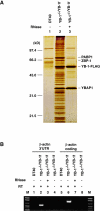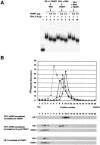An acidic protein, YBAP1, mediates the release of YB-1 from mRNA and relieves the translational repression activity of YB-1
- PMID: 15713634
- PMCID: PMC549371
- DOI: 10.1128/MCB.25.5.1779-1792.2005
An acidic protein, YBAP1, mediates the release of YB-1 from mRNA and relieves the translational repression activity of YB-1
Abstract
Eukaryotic Y-box proteins are nucleic acid-binding proteins implicated in a wide range of gene regulatory mechanisms. They contain the cold shock domain, which is a nucleic acid-binding structure also found in bacterial cold shock proteins. The Y-box protein YB-1 is known to be a core component of messenger ribonucleoprotein particles (mRNPs) in the cytoplasm. Here we disrupted the YB-1 gene in chicken DT40 cells. Through the immunoprecipitation of an epitope-tagged YB-1 protein, which complemented the slow-growth phenotype of YB-1-depleted cells, we isolated YB-1-associated complexes that likely represented general mRNPs in somatic cells. RNase treatment prior to immunoprecipitation led to the identification of a Y-box protein-associated acidic protein (YBAP1). The specific association of YB-1 with YBAP1 resulted in the release of YB-1 from reconstituted YB-1-mRNA complexes, thereby reducing the translational repression caused by YB-1 in the in vitro system. Our data suggest that YBAP1 induces the remodeling of YB-1-mRNA complexes.
Figures








Similar articles
-
Akt-mediated YB-1 phosphorylation activates translation of silent mRNA species.Mol Cell Biol. 2006 Jan;26(1):277-92. doi: 10.1128/MCB.26.1.277-292.2006. Mol Cell Biol. 2006. PMID: 16354698 Free PMC article.
-
The pleiotropic functions of the Y-box-binding protein, YB-1.Bioessays. 2003 Jul;25(7):691-8. doi: 10.1002/bies.10300. Bioessays. 2003. PMID: 12815724 Review.
-
Y-box protein-associated acidic protein (YBAP1/C1QBP) affects the localization and cytoplasmic functions of YB-1.Sci Rep. 2018 Apr 18;8(1):6198. doi: 10.1038/s41598-018-24401-3. Sci Rep. 2018. PMID: 29670170 Free PMC article.
-
YB-1 autoregulates translation of its own mRNA at or prior to the step of 40S ribosomal subunit joining.Mol Cell Biol. 2005 Apr;25(8):3317-23. doi: 10.1128/MCB.25.8.3317-3323.2005. Mol Cell Biol. 2005. PMID: 15798215 Free PMC article.
-
Y-Box Binding Proteins in mRNP Assembly, Translation, and Stability Control.Biomolecules. 2020 Apr 11;10(4):591. doi: 10.3390/biom10040591. Biomolecules. 2020. PMID: 32290447 Free PMC article. Review.
Cited by
-
YB-1 binds to GluR2 mRNA and CaM1 mRNA in the brain and regulates their translational levels in an activity-dependent manner.Cell Mol Neurobiol. 2010 Oct;30(7):1089-100. doi: 10.1007/s10571-010-9541-9. Epub 2010 Jul 8. Cell Mol Neurobiol. 2010. PMID: 20614234 Free PMC article.
-
The N-terminal domain of y-box binding protein-1 induces cell cycle arrest in g2/m phase by binding to cyclin d1.Int J Cell Biol. 2009;2009:243532. doi: 10.1155/2009/243532. Epub 2010 Apr 14. Int J Cell Biol. 2009. PMID: 20414334 Free PMC article.
-
Akt-mediated YB-1 phosphorylation activates translation of silent mRNA species.Mol Cell Biol. 2006 Jan;26(1):277-92. doi: 10.1128/MCB.26.1.277-292.2006. Mol Cell Biol. 2006. PMID: 16354698 Free PMC article.
-
Pleiotropic roles of cold shock domain proteins in plants.Front Plant Sci. 2012 Jan 19;2:116. doi: 10.3389/fpls.2011.00116. eCollection 2011. Front Plant Sci. 2012. PMID: 22639630 Free PMC article.
-
Complement component 1, q subcomponent binding protein is a marker for proliferation in breast cancer.Exp Biol Med (Maywood). 2015 Jul;240(7):846-53. doi: 10.1177/1535370214565075. Epub 2015 Jan 7. Exp Biol Med (Maywood). 2015. PMID: 25573962 Free PMC article.
References
-
- Akey, C. W., and K. Luger. 2003. Histone chaperones and nucleosome assembly. Curr. Opin. Struct. Biol. 13:6-14. - PubMed
-
- Aoki, K., K. Matsumoto, and M. Tsujimoto. 2003. Xenopus cold-inducible RNA-binding protein 2 interacts with ElrA, the Xenopus homolog of HuR, and inhibits deadenylation of specific mRNAs. J. Biol. Chem. 278:48491-48497. - PubMed
-
- Bargou, R. C., K. Jurchott, C. Wagener, S. Bergmann, S. Metzner, K. Bommert, M. Y. Mapara, K. J. Winzer, M. Dietel, B. Dorken, and H. D. Royer. 1997. Nuclear localization and increased levels of transcription factor YB-1 in primary human breast cancers are associated with intrinsic MDR1 gene expression. Nat. Med. 3:447-450. - PubMed
Publication types
MeSH terms
Substances
LinkOut - more resources
Full Text Sources
